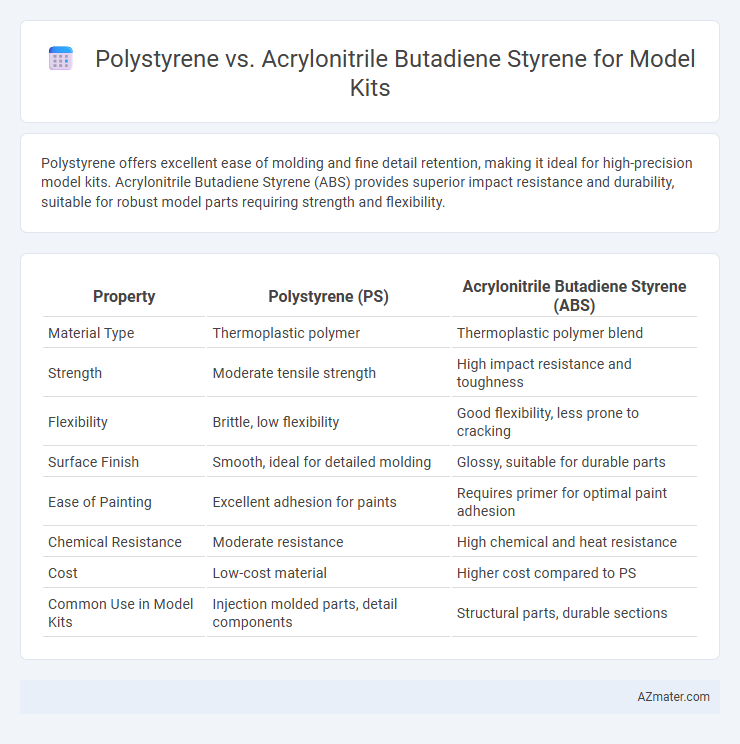Polystyrene offers excellent ease of molding and fine detail retention, making it ideal for high-precision model kits. Acrylonitrile Butadiene Styrene (ABS) provides superior impact resistance and durability, suitable for robust model parts requiring strength and flexibility.
Table of Comparison
| Property | Polystyrene (PS) | Acrylonitrile Butadiene Styrene (ABS) |
|---|---|---|
| Material Type | Thermoplastic polymer | Thermoplastic polymer blend |
| Strength | Moderate tensile strength | High impact resistance and toughness |
| Flexibility | Brittle, low flexibility | Good flexibility, less prone to cracking |
| Surface Finish | Smooth, ideal for detailed molding | Glossy, suitable for durable parts |
| Ease of Painting | Excellent adhesion for paints | Requires primer for optimal paint adhesion |
| Chemical Resistance | Moderate resistance | High chemical and heat resistance |
| Cost | Low-cost material | Higher cost compared to PS |
| Common Use in Model Kits | Injection molded parts, detail components | Structural parts, durable sections |
Introduction: Polystyrene vs ABS for Model Kits
Polystyrene (PS) offers excellent detail precision and is lightweight, making it ideal for intricate model kits and easier painting. Acrylonitrile Butadiene Styrene (ABS) provides superior durability and impact resistance, suitable for parts requiring toughness and structural integrity. Model builders often choose PS for fine detail work and ABS when strength and flexibility are essential components.
Material Composition and Properties
Polystyrene (PS) is a thermoplastic polymer composed mainly of styrene monomers, known for its rigidity, ease of molding, and smooth surface finish, making it ideal for detailed model kits. Acrylonitrile Butadiene Styrene (ABS) combines acrylonitrile, butadiene, and styrene, offering superior impact resistance, toughness, and heat resistance compared to polystyrene. Model kit builders often choose PS for precision and paint adherence, while ABS is preferred for parts requiring enhanced durability and flexibility.
Durability and Strength Comparison
Polystyrene offers excellent rigidity and surface detail, making it ideal for precise model kit assembly but has lower impact resistance compared to Acrylonitrile Butadiene Styrene (ABS). ABS provides superior durability and toughness, with enhanced resistance to cracking and deformation, suitable for models requiring more structural strength and flexibility. For model kits needing strong, long-lasting parts, ABS is preferred, while polystyrene excels in detailed, static displays.
Weight and Flexibility Differences
Polystyrene (PS) is significantly lighter than Acrylonitrile Butadiene Styrene (ABS), making it ideal for model kits that require easy handling and precise detailing. ABS offers greater flexibility and impact resistance, which helps prevent cracking and enhances durability during assembly or modifications. Choosing between PS and ABS depends on the model kit's requirements for weight reduction versus mechanical strength and flexibility.
Ease of Cutting, Sanding, and Shaping
Polystyrene offers superior ease of cutting and shaping due to its soft texture and uniform consistency, making it ideal for intricate model kit details. Acrylonitrile Butadiene Styrene (ABS) is tougher and more impact-resistant but requires sharper tools and more effort during sanding to achieve smooth finishes. Modelers prefer polystyrene for fine sanding and quick modifications, while ABS is favored for durable components that withstand handling and assembly stress.
Adhesive and Bonding Considerations
Polystyrene offers excellent compatibility with solvent-based adhesives such as plastic cement, creating strong, seamless bonds critical for model kit assembly. Acrylonitrile Butadiene Styrene (ABS) requires specialized adhesives like ABS cement or cyanoacrylate glue, as traditional polystyrene cements may not provide reliable adhesion. For optimal bonding, selecting adhesives formulated for each plastic type ensures structural integrity and ease of finishing in model building.
Paintability and Surface Finish
Polystyrene offers superior paint adhesion and a smoother surface finish, making it ideal for detailed model kits requiring fine paintwork and crisp edges. Acrylonitrile Butadiene Styrene (ABS) provides greater durability and impact resistance but can be more challenging to paint due to its slick, oily surface that may require special priming. For model builders prioritizing paintability and a pristine finish, polystyrene remains the preferred choice, while ABS suits applications demanding toughness over aesthetic precision.
Cost and Availability in Hobby Markets
Polystyrene (PS) is widely favored in hobby markets for model kits due to its low cost and high availability, making it an economical choice for beginners and large-scale projects. Acrylonitrile Butadiene Styrene (ABS) tends to be more expensive and less common in standard model kit offerings, though it offers superior strength and durability for advanced applications. Hobby stores and online retailers predominantly stock PS kits, reflecting its dominance driven by affordability and widespread supply.
Environmental Impact and Recycling
Polystyrene (PS) is widely used in model kits due to its ease of molding but poses significant environmental challenges since it is non-biodegradable and difficult to recycle, often ending up in landfills or oceans. Acrylonitrile Butadiene Styrene (ABS) offers better durability but has a more complex chemical structure, making recycling processes energy-intensive and less efficient compared to PS. Both materials contribute to plastic pollution, highlighting the need for improved recycling technologies and the adoption of eco-friendly alternatives in the modeling industry.
Conclusion: Choosing the Best Material for Model Kits
Polystyrene offers ease of painting and precise detailing, making it ideal for beginners and detailed model kits, while Acrylonitrile Butadiene Styrene (ABS) provides superior impact resistance and durability suited for functional parts and models requiring strength. ABS's higher heat resistance benefits complex assemblies exposed to stress or higher temperatures. Selecting between polystyrene and ABS depends on the balance between aesthetic detail and mechanical performance desired in the model kit.

Infographic: Polystyrene vs Acrylonitrile Butadiene Styrene for Model Kit
 azmater.com
azmater.com